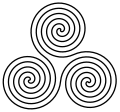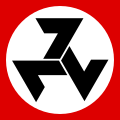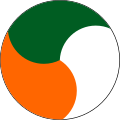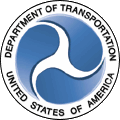Triskelion
This article needs additional citations for verification. (July 2007) |

A triskelion or triskele (both from the Greek [τρισκέλιον] Error: {{Lang}}: text has italic markup (help) or [τρισκελής] Error: {{Lang}}: text has italic markup (help), for "three-legged") is a symbol consisting of three interlocked spirals, or three bent human legs, or any similar symbol with three protrusions and a threefold rotational symmetry.
A triskelion is the symbol of Brittany, as well as the Isle of Man and Sicily (where it is called Trisceli). The Manx and Sicilian triskelions feature three running legs, bent at the knee and conjoined at the crotch. Spiral forms of the triskele are often classed as solar symbols,[citation needed] while the legged version, sometimes including a gorgon mask or Medusa's head at the central axle point in the Sicilian version, suggests a chthonic significance.[citation needed]
Origins
The triskelion symbol appears in many early cultures, including on Mycenaean vessels, on coinage in Lycia, and on staters of Pamphylia (at Aspendos, 370–333 BC) and Pisidia.[citation needed] A symbol of four conjoined legs, a tetraskelion, is also known in Anatolia. Celtic influences in Anatolia, epitomized by the Gauls who invaded and settled Galatia, are especially noted by those who theorize a Celtic origin for the triskelion.[who?]
Manx triskelion

In the symbol for the Isle of Man, which is located in the Irish Sea, the "three legs embowed" of the heraldic triskelion are represented in armour, "spurred and garnished or (gold)."
On Manx banknotes, the triskelion appears within a rim containing the Latin inscription [QUOCUNQUE JECERIS STABIT] Error: {{Lang}}: text has italic markup (help) ("Wherever you throw it, it stands"). The Manx triskelion is documented since the thirteenth or fourteenth century at the latest, and is alternatively known in the Manx language as the [tre cassyn] Error: {{Lang}}: text has italic markup (help) ("three legs"). The symbol appears on the Isle of Man's ancient Sword of State, which may have belonged to Olaf Godredson, who became King of the Sudreys (Southern Hebrides and the Isle of Man) in 1226.
Kneeling clockwise is the correct symbol as it is said that bent or kneeling in an anticlockwise fashion signifies aggression in heraldry (see Swastika).[citation needed] However, many Manx churches and even the Laxey Wheel (Lady Isabella) in Laxey show the anticlockwise version.
Sicilian triskelion
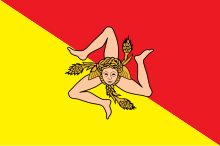
Familiar as an ancient symbol of Sicily, the triskelion is also featured on Greek coins of Syracuse, such as coins of Agathocles (317-289 BCE). In Sicily, the first inhabitants mentioned in history are the tribes of the Sicani (Greek Sikanoi) and the Sicels (Greek Sikeloi), who have given Sicily its more familiar modern name. The triskelion was revived, as a neoclassic—and non-Bourbon—emblem for the new Napoleonic Kingdom of the Two Sicilies, by Joachim Murat in 1808.
The symbol dates back to when Sicily was part of Magna Graecia, the colonial extension of Greece beyond the Aegean.[1] Pliny the Elder attributes the origin of the triskelion of Sicily to the triangular form of the island, the ancient Trinacria, which consists of three large capes equidistant from each other, pointing in their respective directions, the names of which were Pelorus, Pachynus, and Lilybæum.
The three legs of the triskelion are also reminiscent of Hephaestus's three-legged tables that ran by themselves, as mentioned in Iliad xviii:
- "At the moment Hephaestus was busily
- Turning from bellows to bellows, sweating with toil
- As he laboured to finish a score of three-legged tables
- To stand around the sides of his firm-founded hall. On each
- Of the legs he had put a gold wheel, that those magic tables
- Might cause all to marvel by going with no other help
- To the gathering of gods and by likewise returning to his house."
Celtic / Gaelic Triscele
The triscele has been used since ancient times in Celtic culture to symbolize the cycle of life. It has also been a symbol for the trinity since post-pagan times and medieval times in Scotland, Ireland and parts of England and Wales. As with many of the pagan myths and stories that changed during this time period so did the pagan symbols that were once part of the culture in an effort to convert the entirety of celtic culture to Christianity. The triscele also was a symbol for the three goddesses of Celtic mythology [citation needed] (also found in Greek mythology). There is also some debate if it came to be a symbol for wise men, leaders, scholars and people of the arts among the druids an ancients celts alike. Origins of this can be found in Brigid daughter of Dagda (Brigid is one of the three goddesses). When looking at the symbol it is clear to see that spirals move inward therefore also being cited that each spiral symbolizes strength, honor & fortitude. --198.212.208.14 (talk) 21:54, 25 August 2008 (UTC)
Spiral triskele
The Celtic symbol of three conjoined spirals may have had triple significance similar to the imagery that lies behind the triskelion. The triple spiral motif is a Neolithic symbol in Western Europe. It is carved into the rock of a stone lozenge near the main entrance of the prehistoric Newgrange monument in County Meath, Ireland. A variant of the symbol is also found, carved into the wall in the inner chamber of the passage tomb. Because of its Celtic associations, it is also used as a symbol of Brittany (alongside the hermine).
In the north of Spain, the triskelion is used as a symbol of Galizan and Asturian nationalists. A similar symbol called lábaro by Cantabrian regionalist can be compared to the neighboring Basque culture's four-branched lauburu.
A possibly related symbol of Germanic origin is the valknut, and the Celtic and Germanic triquetra.
-
The Neolithic triple spiral symbol.
-
Spiral triskele, found in Celtic artwork, used by Celtic Reconstructionists and occasionally as a Christian Trinitarian symbol.
-
"Horned triskele", rendition of three interlocked drinking horns, from the Viking Age Snoldelev Stone, in Denmark.
Third Reich
The Third Reich adopted a variation on the triskelion as the insignia for a Waffen-SS division composed of Belgian volunteers.
Modern uses
Reconstructionists and Neopagans
The triskele, usually consisting of spirals, but also the "horned triskelion", is used by some Polytheistic Reconstructionist and Neopagan groups. As a Celtic symbol, it is found primarily of groups with a Celtic cultural orientation and, less frequently, can also be found in use by some Germanic Neopagan groups and eclectic or syncretic traditions such as Wicca. The spiral triskele is one of the primary symbols of Celtic Reconstructionist Paganism.[2] Celtic Reconstructionists use the symbol to represent a variety of triplicities in their cosmology and theology; it is also a favored symbol due to its association with the god Manannán mac Lir.[2] Wicca is syncretic in nature and often aesthetically adopts symbolism from various cultures, particularly Celtic symbolism. It is less commonly used amongst Germanic Neopagan groups due to the non-Germanic origins of the symbol; use by Germanic groups may be due to confusion or association with Norse symbols with triple symmetries, like the Valknut, the Triquetra, or the symbol found on the Snoldelev Stone.
BDSM
A form of the triskelion has been proposed as a BDSM Emblem by some BDSM groups, partly based on a description in the Story of O. The specific emblem design is meant to be shown with metallic spokes and circle, and three holes (not dots) within the design.
Political groups
The South African white supremacist paramilitary group, the Afrikaner Weerstandsbeweging (AWB), have used a flag consisting of a red background with a white circle. In the circle, three black sevens form a design distantly reminiscent of the triskelion. In spite of the similarities to the swastika (and the overall resemblance to the Nazi flag, both having a black symbol on a white disc on a red background), they claim their flag is inspired by a Biblical meaning of the seven, and the fact that the organisation was founded on the seventh day of the seventh month, 1973 (from which the three 7's can be extracted)
Gallery of triskeles
-
A symbol closely resembling the BDSM emblem defined by Quagmyr
-
The flag of the Afrikaner Weerstandsbeweging.
-
The triskelion symbol on the Tau Gamma Phi logo, also known as the Triskelion Grand Fraternity.
-
The triskelion symbol on the Tau Gamma Sigma logo, also known as the Triskelion Grand Sorority.
-
Irish Air Corps Roundel.
-
Seal of the United States Department of Transportation.
-
Flag of the Ryukyu Islands from 1875 to 1879.
Other uses
- A triskelion is shown on the seals of both Tau Gamma Phi and Tau Gamma Sigma, a Fraternity and Sorority founded at the University of the Philippines, Diliman in Quezon City, Philippines. A member is called a Triskelion, hence the name the Triskelion Grand Fraternity and Sorority. The triskelion is accompanied by the motto "FORTIS VOLUNTAS FRATERNITAS/SORORITAS" (Strength, Freewill and Brotherhood/Sisterhood) on their seals.
- A triskelion shape is the basis for the roundel of the Irish Air Corps (unique among air force roundels). It is loosely based on the Flag of Ireland and traditional Celtic triskele boss designs.
- A triskelion pattern forms part of the United States Department of Transportation. The three spirals represent air, land, and sea transportation. The seal was adopted on February 1, 1967.
- A fractal version of the triskelion, consisting of a large blue-silver raised dot with three curved arms of similar dots around it, is a major motif of the 2005 TV series Threshold. It is the symbol of the aliens who invade Earth.
- A three-colored, slightly asymmetrical triskelon is the most common symbol of the Klingons from the Star Trek franchise since their first appearance in the original series. Its meaning within the context of the Star Trek universe has never been explained.
- An episode of Star Trek, The Gamesters of Triskelion, takes place on the alien planet of Triskelion.
- Triskelion is the name of the Gay–straight alliance (GSA) at Brandeis University, one of the oldest such organizations on the East Coast. It was named for the Star Trek episode.
- These symbols are also used in the crest of certain families that reside in the British isles, such as Murray.
- Triskellion is also a card found in the game of "Magic: the Gathering." It depicts a creature that has three arms that can be fired off for a single damage each, accurately capturing the meaning of the word.
- Clathrin, a protein involved in the creation of endocytic vesicles in most cells, also presents a triskelion shape.[citation needed]
See also
References
- ^ Matthews, Jeff (2005) Symbols of Naples
- ^ a b Bonewits, Isaac (2006) Bonewits's Essential Guide to Druidism. New York, Kensington Publishing Group ISBN 0-8065-2710-2. p.132: [Among Celtic Reconstructionists] "...An Thríbhís Mhòr (the great triple spiral) came into common use to refer to the three realms." Also p. 134: [On CRs] "Using Celtic symbols such as triskeles and spirals"

